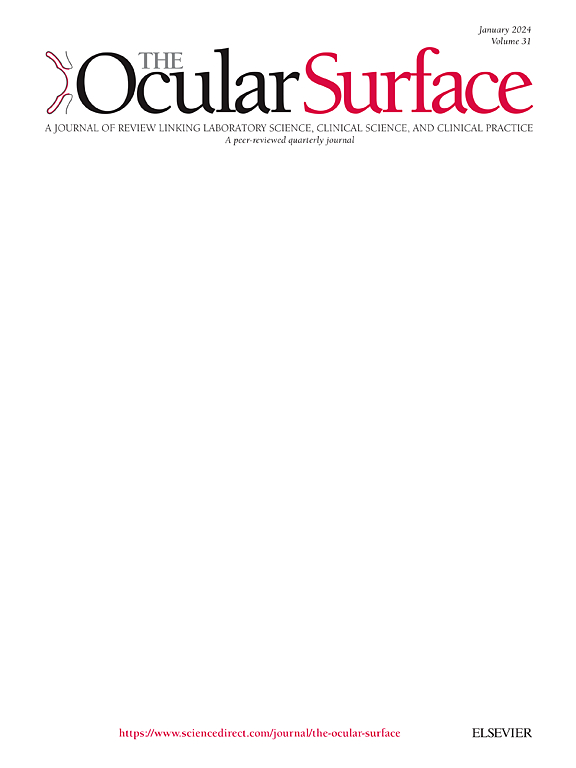干眼病的局部药物治疗:系统综述。
IF 5.6
1区 医学
Q1 OPHTHALMOLOGY
引用次数: 0
摘要
背景:干眼病(DED)的局部药物治疗通过减少眼表炎症、刺激黏液分泌、增加泪液产生或减少过度蒸发来解决泪膜缺乏的不同方面。本系统综述评价了局部眼科药物治疗DED的随机对照试验(rct)和前瞻性观察性研究。方法:检索1980 ~ 2024年2月PubMed和Embase数据库。对于符合纳入标准的研究,提取疗效结局(DED的体征和症状)和不良事件数据。结果:共有107篇出版物涵盖了外用处方药(抗炎药环孢素和利替格司;粘蛋白分泌剂:双喹福醇和利巴米胺;撕裂蒸发抑制剂全氟己辛烷;确定了泪液产生刺激剂(varenicline鼻喷雾剂),其他市售产品和正在开发的新型药物。在随机对照试验中,与对照组相比,体征终点(如角膜染色、Schirmer评分)比症状终点(如眼睛干燥、眼部不适)更常表现出显著的改善。经评估的治疗方法耐受性良好;注射部位反应是最常见的不良事件。为期一年的安全性扩展研究表明,该药物维持了疗效,未发现新的安全信号。研究在设计、方法、对照组和结果评估方面存在差异,这使得很难对不同产品进行比较,而且针锋相对的研究很少。一些新产品正处于后期开发阶段,这可能会带来更多的治疗选择。结论:目前的局部药物眼科产品改善了DED的体征,有时是症状,并且耐受性良好。治疗选择应采用共同决策的方法,将DED病因和患者偏好考虑在内。本文章由计算机程序翻译,如有差异,请以英文原文为准。
Topical pharmacologic treatments for dry eye disease: A systematic review
Background
Topical pharmacologic treatments for dry eye disease (DED) address different aspects of tear film deficiency by decreasing ocular surface inflammation, stimulating mucin secretion, increasing tear production, or reducing excessive evaporation. This systematic review evaluated randomized controlled trials (RCTs) and prospective observational studies of topical ophthalmic medications for DED.
Methods
PubMed and Embase were searched from 1980 to February 2024. For studies meeting inclusion criteria, efficacy outcomes (signs and symptoms of DED) and adverse event data were extracted.
Results
A total of 107 publications covering topical prescription medications (anti-inflammatory agents cyclosporine and lifitegrast; mucin secretagogues diquafosol and rebamipide; tear evaporation inhibitor perfluorohexyloctane; tear production stimulator nasal spray varenicline), other commercially available products, and novel agents in development were identified. In RCTs, significant improvements relative to a control group were demonstrated more often for sign endpoints (e.g., corneal staining, Schirmer score) than for symptom endpoints (e.g., eye dryness, ocular discomfort). The evaluated treatments were well tolerated; instillation site reactions were the most commonly reported adverse events. Year-long safety extension studies demonstrated maintenance of efficacy, with no new safety signals identified. Studies differed in design, methodology, control group, and outcomes assessment, making it difficult to compare across products, and head-to-head studies were rare. Several new products are in late-stage development, which will likely lead to additional treatment options.
Conclusions
Current topical pharmacologic eye products improved signs, and sometimes symptoms, of DED and were well tolerated. Treatment selection should use a shared decision-making approach that takes DED etiology and patient preferences into account.
求助全文
通过发布文献求助,成功后即可免费获取论文全文。
去求助
来源期刊

Ocular Surface
医学-眼科学
CiteScore
11.60
自引率
14.10%
发文量
97
审稿时长
39 days
期刊介绍:
The Ocular Surface, a quarterly, a peer-reviewed journal, is an authoritative resource that integrates and interprets major findings in diverse fields related to the ocular surface, including ophthalmology, optometry, genetics, molecular biology, pharmacology, immunology, infectious disease, and epidemiology. Its critical review articles cover the most current knowledge on medical and surgical management of ocular surface pathology, new understandings of ocular surface physiology, the meaning of recent discoveries on how the ocular surface responds to injury and disease, and updates on drug and device development. The journal also publishes select original research reports and articles describing cutting-edge techniques and technology in the field.
Benefits to authors
We also provide many author benefits, such as free PDFs, a liberal copyright policy, special discounts on Elsevier publications and much more. Please click here for more information on our author services.
Please see our Guide for Authors for information on article submission. If you require any further information or help, please visit our Support Center
 求助内容:
求助内容: 应助结果提醒方式:
应助结果提醒方式:


